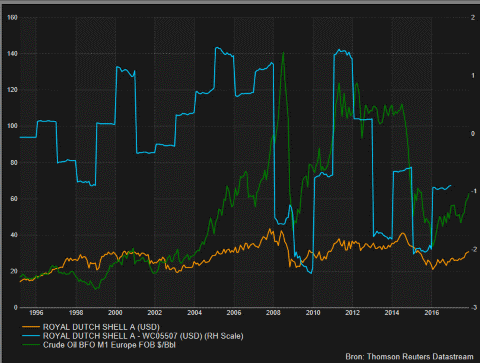Met nu +2,6% en haar indexgewicht van 15,5% geeft Royal Dutch Shell de AEX een zetje. Opbeurend bericht vanochtend van Ben. Sein veilig bestaat niet in het leven en zeker niet op de beurs, maar er walmt dikke, vette, witte rook uit de schoorsteen van het hoofdkantoor in Den Haag.
De vrije kasstroom is gered en daar gaat u als aandeelhouder van profiteren. Dit meldt de gigant op haar capital markets day, de vrije kasstroom gaat in de komende drie jaar naar $25 à $30 miljard en het concern gaat voor $25 miljard aan eigen aandelen inkopen. Er staan ruim 8 miljard aandelen uit, dus reken maar uit.
- The outlook for annual organic free cash flow has increased to $25 to $30 billion by 2020 at a Brent crude oil price of $60 per barrel (real terms 2016). This is $5 billion more than the outlook Shell provided during its capital markets day in June 2016.
- Debt reduction remains a priority. Gearing stood at 25.4% at the end of Q3 2017 and additional divestment proceeds of more than $5 billion since then mean that 20% gearing is in sight.
- The delivery of new projects continues, and the company remains on track to deliver 1 million barrels of oil equivalent per day, and $10 billion of cash flow from operations from new projects by 2018 (at $60 per barrel, real terms 2016). We expect to deliver an incremental $5 billion cash flow from operations by 2020.
- The $30 billion divestment programme between 2016 and 2018 is almost delivered, with deals worth $23 billion completed (headline), $2 billion announced, and $5 billion in advanced progress. Once this programme is completed the company expects to continue divestments at an average rate of more than $5 billion until at least 2020.
- The company’s commitment to capital discipline remains. Annual capital investment will continue to be between $25 and $30 billion, and at current oil prices capital investment will be managed towards the bottom end of that range, or lower if needed.
- Annual underlying operational expenditure will remain below $38 billion until 2020, with efficiency gains expected to deliver further reductions, building on the more than 20% reduction in operational expenditure since 2014.
- The company expects to continue to grow organic free cash flow throughout the 2020s at a more moderate rate. Increased distributions to shareholders in the form of share buybacks in line with the plans confirmed below is expected to support a stronger growth in its metrics per share.
- As per intentions stated in December 2015 at the time of the combination with BG, the company is confirming the plans for share buybacks of at least $25 billion in the period 2017-2020, subject to progress with debt reduction and recovery in oil prices.

Cash, cash en nog eens cash
Hoe zit eigenlijk met die cashflow, die valt of staat natuurlijk met de olieprijs. Hier ziet u koers, vrije kasstroom per kwartaal per aandeel en Brent. Doet een beetje aan 2006 en 2007 denken?
Verhip, de koers stond toen ook rond de huidige niveaus. Het aandeel Shell wordt wel eens een veredelde obligatie genoemd, omdat u het niet van de koers maar van de coupon of dividend moet hebben. Klopt. Eén ding komt niet ter sprake in het persbericht: of Olies alweer aan een dividendverhoging denkt.
Eerst maar die aandeleninkoop afronden en de olieprijs afwachten, lijkt me? Vraagteken, want CEO Ben van Beurden verrast vaker. Als Brent verder stijgt klotst de cash al snel over de plinten bij de mean & lean Koninklijke, maar dat verleidt het bedrijf zeker niet tot gekke dingen. Eerder meer investeringen?
Uiteraard wordt alles wel minder als olie weer gaat dalen. Niet genoemd in het persbericht, maar bij mijn weten heeft Shell tot $40 vet op de botten. Daaronder wordt het weer afknijpen. Dat is het worst case scenario. Daar denken we na ruim drie magere jaren maar even niet aan. Welcome back Shell!
Arend Jan Kamp is
senior content manager van IEX. De informatie in dit artikel is niet bedoeld
als professioneel beleggingsadvies of als aanbeveling tot het doen van bepaalde
beleggingen.